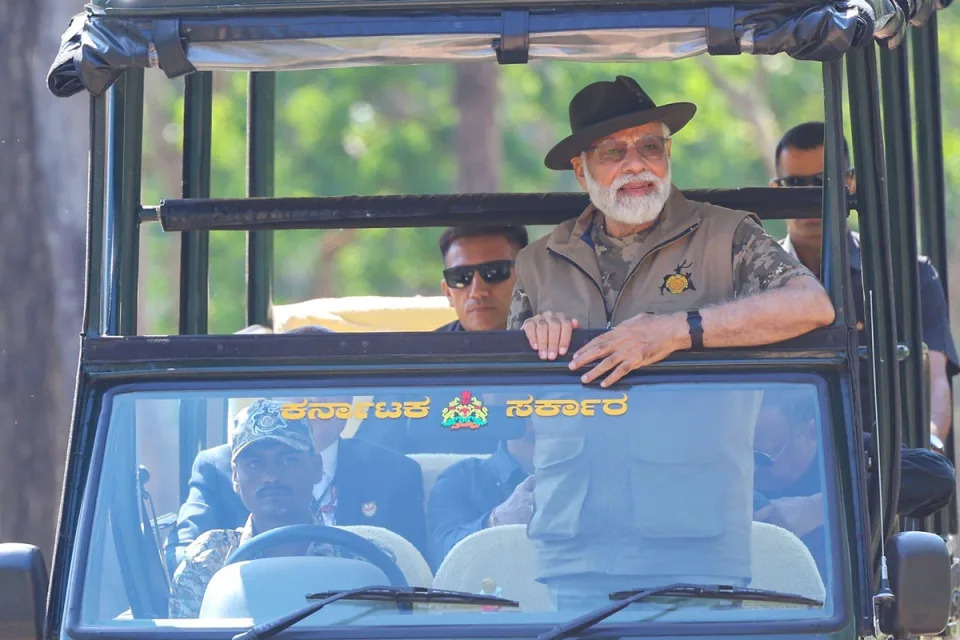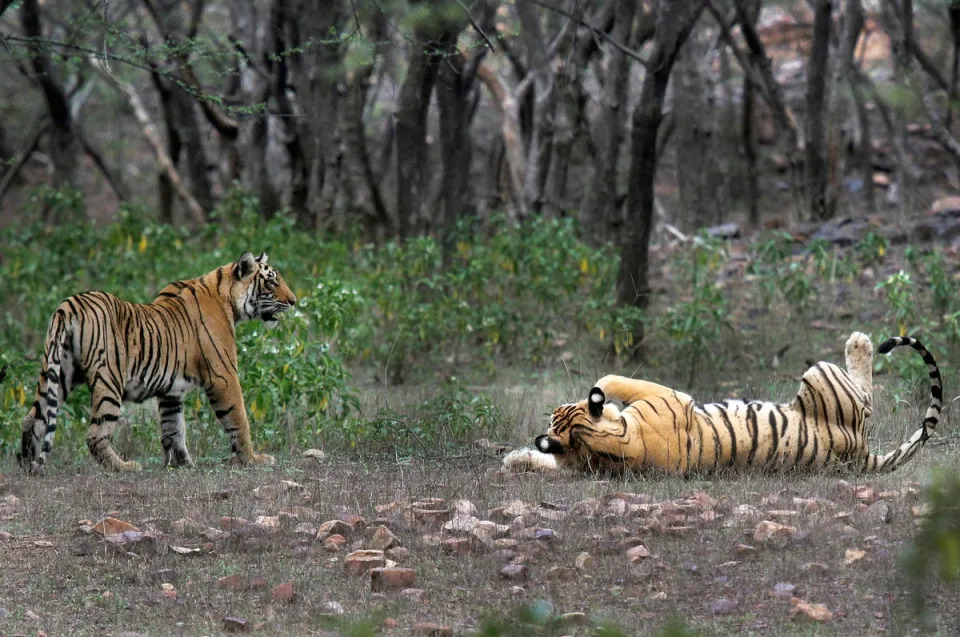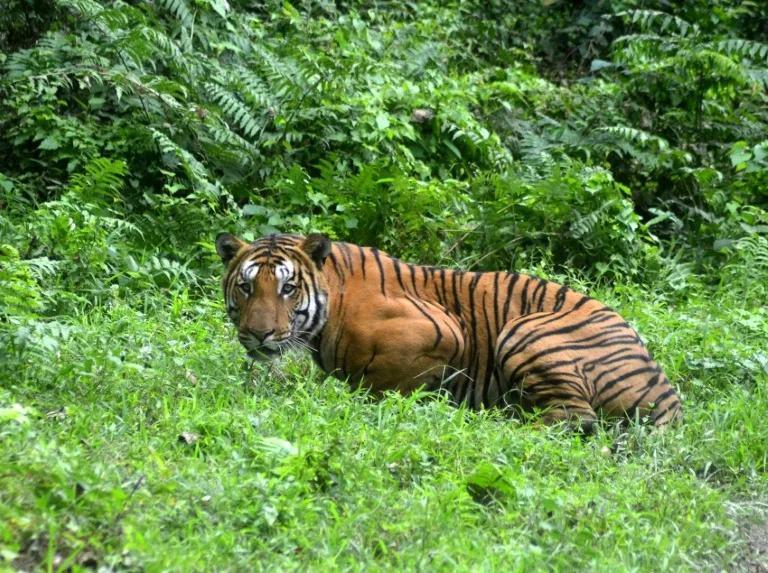India now home to 75% of world’s tiger population as numbers surge
Namita Singh
Sun, 9 April 2023

This handout photograph taken on 9 April 2023 and released by the Indian Press Information Bureau (PIB) shows India’s prime minister Narendra Modi taking a jungle safari during his visit to the Bandipur and Mudumalai Tiger Reserves, in Karnataka state (PIB/AFP via Getty Images)
The tiger population in India has steadily grown to over 3,000 since the flagship conservation programme began five decades ago, showed the census data revealed by prime minister Narendra Modi on Sunday.
According to the official figures, the numbers grew from 2,967 in 2018 to 3,167 by the end of last year.
The data revealed that the tigers in the country almost doubled in the last 17 years. While in 2006, the tiger count was at 1,411, it jumped to 1,706 in 2010.
“The success of Project Tiger is a matter of pride not only for India but also for the world,” said Mr Modi, during the 50th anniversary of Project Tiger.
“Our country has not only conserved tigers but has also given them an ecosystem to flourish. India is a country which believes in the co-existence of economy and ecology. We are also the largest tiger range country in the world,” said the prime minister as he visited the Bandipur Tiger Reserve in the poll-bound southern Indian state of Karnataka.
With the current count of over 3,000, India is home to more than 75 per cent of the global tiger population and their number is increasing by 6 per cent per annum, according to government figures.

File: Tigers are visible at the Ranthambore National Park in Sawai Madhopur, India on 12 April 2015 (AP)
India first launched Project Tiger under then-prime minister Indira Gandhi on 1 April 1973 after a census of the big cats found India’s tigers were fast going extinct through habitat loss, unregulated sport hunting, increased poaching, and retaliatory killing by people.
While it initially covered nine tiger reserves spread over 18,278 sq km, India now has 53 reserves covering more than 75,000 sq km (approximately 2.4 per cent of the country’s geographical area).

Former Indian prime minister Indira Gandhi kickstarted Project Tiger at Corbett National Park on 1 April 1973 (Twitter/Jairam_Ramesh)
It’s believed the tiger population was around 1,800 at the time, but experts widely consider that an overestimate due to imprecise counting methods in India until 2006.
“The huge success and the increase in number of tigers proved how much the country thrives for saving our wildlife,” said Mr Modi as he stressed on the significance of big cats in Hindu religious texts.
“There is a mention of tigers in our mythological scriptures and even on historical carvings. They have been an important species in the ecosystem.”

This handout photograph taken on 9 April 2023 and released by the Indian Press Information Bureau (PIB) shows India’s prime minister Narendra Modi taking photographs during his visit to the Bandipur and Mudumalai Tiger Reserves, in Karnataka state (PIB/AFP via Getty Images)
Tigers have disappeared in Bali and Java and China’s tigers are likely extinct in the wild. The Sunda Island tiger, the other sub-species, is only found in Sumatra. India’s project to safeguard them has been praised as a success by many.
"Project Tiger hardly has a parallel in the world since a scheme of this scale and magnitude has not been so successful elsewhere," said additional director general of forests SP Yadav, who is in charge of Project Tiger.
India's tiger population rises above 3,000Namita Singh
Sun, 9 April 2023

This handout photograph taken on 9 April 2023 and released by the Indian Press Information Bureau (PIB) shows India’s prime minister Narendra Modi taking a jungle safari during his visit to the Bandipur and Mudumalai Tiger Reserves, in Karnataka state (PIB/AFP via Getty Images)
The tiger population in India has steadily grown to over 3,000 since the flagship conservation programme began five decades ago, showed the census data revealed by prime minister Narendra Modi on Sunday.
According to the official figures, the numbers grew from 2,967 in 2018 to 3,167 by the end of last year.
The data revealed that the tigers in the country almost doubled in the last 17 years. While in 2006, the tiger count was at 1,411, it jumped to 1,706 in 2010.
“The success of Project Tiger is a matter of pride not only for India but also for the world,” said Mr Modi, during the 50th anniversary of Project Tiger.
“Our country has not only conserved tigers but has also given them an ecosystem to flourish. India is a country which believes in the co-existence of economy and ecology. We are also the largest tiger range country in the world,” said the prime minister as he visited the Bandipur Tiger Reserve in the poll-bound southern Indian state of Karnataka.
With the current count of over 3,000, India is home to more than 75 per cent of the global tiger population and their number is increasing by 6 per cent per annum, according to government figures.

File: Tigers are visible at the Ranthambore National Park in Sawai Madhopur, India on 12 April 2015 (AP)
India first launched Project Tiger under then-prime minister Indira Gandhi on 1 April 1973 after a census of the big cats found India’s tigers were fast going extinct through habitat loss, unregulated sport hunting, increased poaching, and retaliatory killing by people.
While it initially covered nine tiger reserves spread over 18,278 sq km, India now has 53 reserves covering more than 75,000 sq km (approximately 2.4 per cent of the country’s geographical area).

Former Indian prime minister Indira Gandhi kickstarted Project Tiger at Corbett National Park on 1 April 1973 (Twitter/Jairam_Ramesh)
It’s believed the tiger population was around 1,800 at the time, but experts widely consider that an overestimate due to imprecise counting methods in India until 2006.
“The huge success and the increase in number of tigers proved how much the country thrives for saving our wildlife,” said Mr Modi as he stressed on the significance of big cats in Hindu religious texts.
“There is a mention of tigers in our mythological scriptures and even on historical carvings. They have been an important species in the ecosystem.”

This handout photograph taken on 9 April 2023 and released by the Indian Press Information Bureau (PIB) shows India’s prime minister Narendra Modi taking photographs during his visit to the Bandipur and Mudumalai Tiger Reserves, in Karnataka state (PIB/AFP via Getty Images)
Tigers have disappeared in Bali and Java and China’s tigers are likely extinct in the wild. The Sunda Island tiger, the other sub-species, is only found in Sumatra. India’s project to safeguard them has been praised as a success by many.
"Project Tiger hardly has a parallel in the world since a scheme of this scale and magnitude has not been so successful elsewhere," said additional director general of forests SP Yadav, who is in charge of Project Tiger.
AFP
Sun, 9 April 2023

India's wild tiger population -- by far the largest in the world -- has risen above 3,000, according to a census released Sunday, boosting efforts to conserve the endangered species.
The largest of all cats, tigers once roamed throughout central, eastern and southern Asia.
But in the past 100 years the tiger has lost more than 93 per cent of its historic range and now only survives in scattered populations in 13 countries, according to the International Union for Conservation of Nature (IUCN).
The Indian census estimated there were 3,167 tigers in the wild across the country, up from 2,967 reported in the last such exercise.
Surveys are conducted every four years, using camera traps and computer programs to individually identify each creature.
The rate of increase has slowed to less than seven percent over the period, down from more than 30 percent in the previous four years.
But Prime Minister Narendra Modi said the new figure was a "proud moment".
"Our family is expanding," he said at a ceremony in the southern city of Mysuru. "This is a matter of pride not not only for India but the entire world."
Deforestation, poaching and human encroachment on habitats have devastated tiger populations across Asia but Modi said India had been able to increase its numbers thanks to "people's participation" and the country's "culture of conservation".
India is now home to 75 percent of the global tiger population and also the "largest tiger range country in the world", he added.
In 1900, more than 100,000 tigers were estimated to roam the planet. But that fell to a record low of 3,200 in 2010.
That year, India and 12 other countries with tiger populations signed an agreement to double their big cat numbers by 2022.
India is believed to have had a tiger population of around 40,000 at the time of independence from Britain in 1947.
That fell over subsequent decades to about 3,700 in 2002 and an all-time low of 1,411 four years later, but numbers have since risen steadily.
Dipankar Ghose, director of the wildlife and habitats programme at the World Wide Fund for Nature-India told AFP the latest increase in tiger numbers was encouraging.
"On the other hand it also tells us that each of us now need to work harder to restore degraded habitats, ensure safe movement of tigers through corridors and promote coexistence," he added.
abh/slb/leg
No comments:
Post a Comment